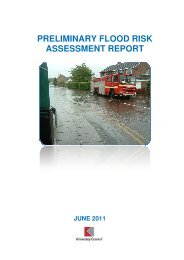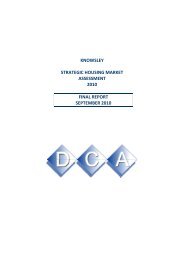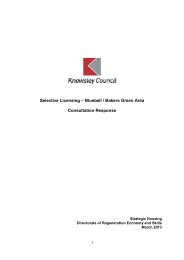Knowsley Replacement Unitary Development Plan - Knowsley Council
Knowsley Replacement Unitary Development Plan - Knowsley Council
Knowsley Replacement Unitary Development Plan - Knowsley Council
You also want an ePaper? Increase the reach of your titles
YUMPU automatically turns print PDFs into web optimized ePapers that Google loves.
ECONOMIC DEVELOPMENT<br />
ECONOMIC DEVELOPMENT<br />
CURRENT ISSUES<br />
6.4<br />
Over recent years significant progress has been made<br />
in tackling the legacy of economic decline from the<br />
1970s and 1980s. Over 4,500 jobs have been created<br />
in new developments since 1995, and the <strong>Council</strong> and<br />
its partners have carried out significant work in<br />
upgrading the environment of the industrial areas in<br />
<strong>Knowsley</strong>. However, a number of significant issues<br />
remain as follows:<br />
• The Borough has an under representation of<br />
growth industries, such as information and<br />
communications technology, biotechnology,<br />
financial and professional services and<br />
creative industries;<br />
• The unemployment rate (at 4.0% - see footnote 3 )<br />
is higher than the average for Merseyside as a<br />
whole (3.7%), and is significantly higher than the<br />
North West and national averages (2.4% and 2.3%<br />
respectively). Male unemployment is<br />
approximately three times the female rate (6.2%<br />
and 1.9% respectively) and a high percentage of<br />
unemployment claimants are under 25 years of<br />
age (34.0%). Second and third generation<br />
unemployment is not unusual;<br />
• Unemployment is particularly high in certain<br />
areas; Cantril Farm ward (now known as<br />
Stockbridge) has a rate of 8.3%, while Princess<br />
ward has a rate of 7.3% (see footnote 4 ) (over<br />
three times the North West average); and<br />
• The number of people claiming Incapacity Benefit<br />
(IB) and Disability Living Allowance (DLA) was<br />
more than two and a half times the number of<br />
people claiming Job Seekers Allowance in 2001,<br />
with rates for claiming IB and DLA both over<br />
twice the national average. IB and DLA claimants<br />
generally cannot work full time and this<br />
illustrates that the amount of non-employed<br />
people in <strong>Knowsley</strong> is larger than the Job Seekers<br />
Allowance rate.<br />
TACKLING THE ISSUES<br />
6.5<br />
The <strong>Council</strong> intends to strengthen the local economy<br />
by promoting new employment generating uses,<br />
particularly within the target growth sectors<br />
identified by the North West <strong>Development</strong> Agency’s<br />
Regional Economic Strategy (2003), and by meeting<br />
the needs of established employers. The <strong>Council</strong> has<br />
identified the following priorities and needs:<br />
• To provide more high quality sites<br />
and premises;<br />
• To improve “gateways” to the Borough and<br />
transport corridors;<br />
• To implement physical regeneration strategies for<br />
the Industrial Parks, incorporating improvements<br />
to the landscape, provision of services to<br />
development sites, better security, and<br />
improvement/remediation of vacant sites;<br />
• To improve and provide new tourism and<br />
leisure facilities;<br />
• To improve business start up rates and create a<br />
more vibrant enterprise culture; and<br />
• To improve public transport linkages between<br />
employment areas and non-employment areas to<br />
improve access to jobs for those without cars and<br />
to encourage use of more sustainable forms of<br />
transport for those currently using cars.<br />
KEY ECONOMIC SECTORS AND<br />
“CLUSTER” DEVELOPMENTS<br />
6.6<br />
Key economic sectors, identified by the North West<br />
<strong>Development</strong> Agency in the Regional (Economic)<br />
Strategy (2000) 5 , are now listed in the Regional<br />
Spatial Strategy for the North West.<br />
These sectors include:<br />
• Established target sectors, which are important<br />
because of their existing scale and contribution to<br />
the regional economy, and<br />
• Target growth industries, which have the greatest<br />
potential for growth.<br />
The sites identified in this chapter of the UDP are<br />
capable of meeting the likely need for the former to<br />
expand or relocate to more appropriate premises and<br />
to attract the latter to the Borough.<br />
6.7<br />
The update of the Regional (Economic) Strategy,<br />
published in 2003, encouraged the provision of<br />
clusters. Clusters are geographically concentrated<br />
groups of industries that trade with each other or<br />
which share the same infrastructure, customers or<br />
skills base and whose linkages enhance competitive<br />
advantage. This critical mass provides the right<br />
operating environment for growth companies and<br />
provides opportunities for new start-up companies<br />
and inward investment. The industries which are<br />
suitable for cluster development are identified in<br />
figure 6.1. An opportunity for cluster development in<br />
<strong>Knowsley</strong> exists with the Jaguar plant in Halewood<br />
and the possibility of attracting suppliers to <strong>Knowsley</strong>.<br />
Potential provision for this is made with the allocation<br />
of land adjacent to the factory for employment use.<br />
Figure 6.1: Established Target Sectors<br />
• Chemicals;<br />
• Textiles;<br />
• Aerospace;<br />
• Mechanical and other engineering industries,<br />
including marine industries;<br />
• Energy;<br />
• Automotive;<br />
• Food and drink; and<br />
• Land-based industries (primary agriculture<br />
and forestry and diversification of the<br />
rural economy).<br />
Growth target sectors:<br />
• Environmental technologies;<br />
• Life science industries (biotechnology and<br />
pharmaceuticals);<br />
• Medical equipment and technology;<br />
• Financial and professional services;<br />
• Tourism;<br />
• Computer software and services/internet<br />
based services (Digital industries); and<br />
• Creative industries, media, advertising and<br />
public relations.<br />
Industries suitable for “cluster” development<br />
Aerospace, Automotive, Aviation, Chemicals,<br />
Construction, Creative Industries, Digital<br />
Industries, Energy, Environmental Technology,<br />
Financial and Professional Services, Food & Drink,<br />
Healthcare (including Biotechnology), Maritime,<br />
Sport, Textiles, Tourism.<br />
Source: North West <strong>Development</strong> Agency Regional<br />
(Economic) Strategy (2000) cited in the Regional<br />
Spatial Strategy for the North West (March 2003) and<br />
Regional (Economic) Strategy 2003.<br />
3 All unemployment figures given are the Jobseekers Allowance claimant rate. Source: NOMIS, July 2004<br />
4 This information is only available based on the old <strong>Knowsley</strong> ward boundaries (dating before the re-organisation of the<br />
Borough’s wards in 2003)<br />
5 The Regional (Economic) Strategy (RES) was published by the North West <strong>Development</strong> Agency in 2000. The RES was<br />
updated in 2003, with certain changes such as a change in emphasis from supporting established business (target)<br />
sectors and growth target sectors to a strategy for encouraging clusters of businesses. The Regional Spatial Strategy<br />
for the North West (published in 2003) was adopted in March 2003, and supports key economic sectors and clusters.<br />
50<br />
KNOWSLEY REPLACEMENT UNITARY DEVELOPMENT PLAN: Adopted June 2006<br />
51

















